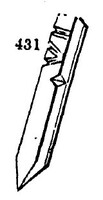1793. The common tally (tailler, Fr.), or number-stick (fig. 431.), is a slip of lath, or deal, or a piece of a rod, nine or twelve inches long, sharpened at one end and squared at the other. The numbers, to nine inclusive, are cut on the face with a knife in Roman numerals (I, II, III, IV, V, VI, VII, VIII, IX.); reading always from the inserted or sharpened end. Ten is formed by a notch or tally on the near angle, and, placed behind the above numerals, extends the series from eleven to nineteen. Twenty is formed by two notches, thirty by three, and so on: the nine numerals above being placed after the notches, so as to form the intermediate terms of the series. Fifty, instead of five notches, is formed by a cross cut, or channel, like I, on the face, with a similar one on the right side joined to it. One hundred is formed by joining to these two cuts a similar cut on the other side, that is, a channel continued on three sides; and one hundred and fifty, by a cut or channel continued on the four sides of the stick. Ninety may be more readily formed by using the mark for one hundred, and placing a notch behind it, to signify 100 less 10, than by using the cuts for fifty, and adding four notches before. Other high numbers may be simplified in the same manner. A little reflection will show that this mode of numbering may be carried to almost any extent; and in some nurseries, particularly in Scotland, we have known it carried as far as five hundred, which is formed by only three rings for 150 x 3 = 450, and a half ring for 50. Particular attention must always be had to read from the root or insertion end.

